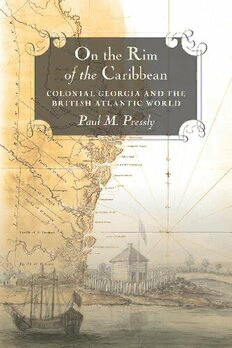
On the Rim of the Caribbean: Colonial Georgia and the British Atlantic World PDF
Preview On the Rim of the Caribbean: Colonial Georgia and the British Atlantic World
On the Rim of the Caribbean This page intentionally left blank On the Rim of the Caribbean Colonial Georgia and the British Atlantic World paul m. pressly The University of Georgia Press Athens and London © 2013 by the University of Georgia Press Athens, Georgia 30602 www.ugapress.org All rights reserved Set in Adobe Caslon Pro by Graphic Composition, Inc., Bogart, Georgia Cartography by David Wasserboehr, Flying W Graphics Printed digitally in the United States of America Library of Congress C ataloging- in- Publication Data Pressly, Paul M. On the rim of the Caribbean : colonial Georgia and the British Atlantic world / Paul M. Pressly. p. cm. Includes bibliographical references and index. isbn-13: 978-0-8203-3567-4 (hardcover : alk. paper) isbn-10: 0-8203-3567-3 (hardcover : alk. paper) isbn-13: 978-0-8203-4503-1 (pbk. : alk. paper) isbn-10: 0-8203-4503-2 (pbk. : alk. paper) 1. Georgia—Economic conditions—18th century. 2. Georgia—Commerce—West Indies, British—History—18th century. 3. West Indies, British—Commerce— Georgia—History—18th century. 4. Plantations—Georgia—History—18th century. 5. Georgia—History—Colonial period, ca. 1600–1775. I. Title. f289.p74 2013 975.8'02—dc23 2012033964 British Library Cataloging- in- Publication Data available ISBNfordigitaledition:978-08203-4580-2 In memory of my parents, William Laurens & Alice McCallie Pressly And in honor of Jane, Bill, and Nancy This page intentionally left blank Contents Illustrations follow page 92 Preface ix Maps xii Introduction 1 chapter one The Three Georgias 11 chapter two Merging Planting Elites 32 chapter three The West Indies, Cornerstone of Trade 50 chapter four Savannah as a “Caribbean” Town 69 chapter five Merchants in a Creole Society 93 chapter six The Slave Trade in Creating a Black Georgia 112 chapter seven The Making of the Lowcountry Plantation 134 chapter eight Georgia’s Rice and the Atlantic World 153 chapter nine Retailing the “Baubles of Britain” 172 chapter ten The Trade in Deerskins and Rum 193 chapter eleven Nationalizing the Lowcountry 213 Notes 229 Bibliography 301 Index 337 Preface In the early summer of 2006, I led a group of residents from the community of Pin Point, outside Savannah, to Ossabaw Island to look at the remains of the North End Plantation, including three tabby cabins that the Georgia state archaeologist has described as the best preserved in the state. As head of an education alliance, I knew that some of the community members were descended from enslaved people who had labored on the plantations of this island, now a heritage preserve with t wenty-s ix thousand acres of marsh and maritime forest accessible only by boat. We were not prepared for their reactions. Several of the older members became excited when they stood before those tabbies constructed of oyster shells, lime, sand, and water. They had lived in the cabins as children during the 1940s, when their parents had worked for the owners of Ossabaw, and pointed out details of the living ar- rangements that re-c reated for us a way of life that seemed closer to an- other time. They retain a strong feeling for this island, which has been a part of their families for over two centuries. In an interview, Bo Bowens told how people often asked him about his accent and whether he was from the Caribbean. He would reply, “No! I am from someplace special and beauti- ful. I’m from Ossabaw!” On the coast of Georgia, the eighteenth century is closer than one would think. Pin Point has ties to the enslaved people who fi rst came to the is- lands from Africa in the 1760s to grow indigo, herd cattle, and build ocean- going vessels. My work in helping to interpret the stories around the North End Plantation provided an essential spur to this book. Motivated by this experience, I pulled together a symposium about African American life and culture in the Georgia Lowcountry from the eighteenth century to the twentieth. Out of that eff ort came a gathering of distinguished scholars, an audience of several hundred people, and a book that fi lls a gap in the subject matter. What also emerged were close working relationships with people who have extended extraordinary help to me in this enterprise.
